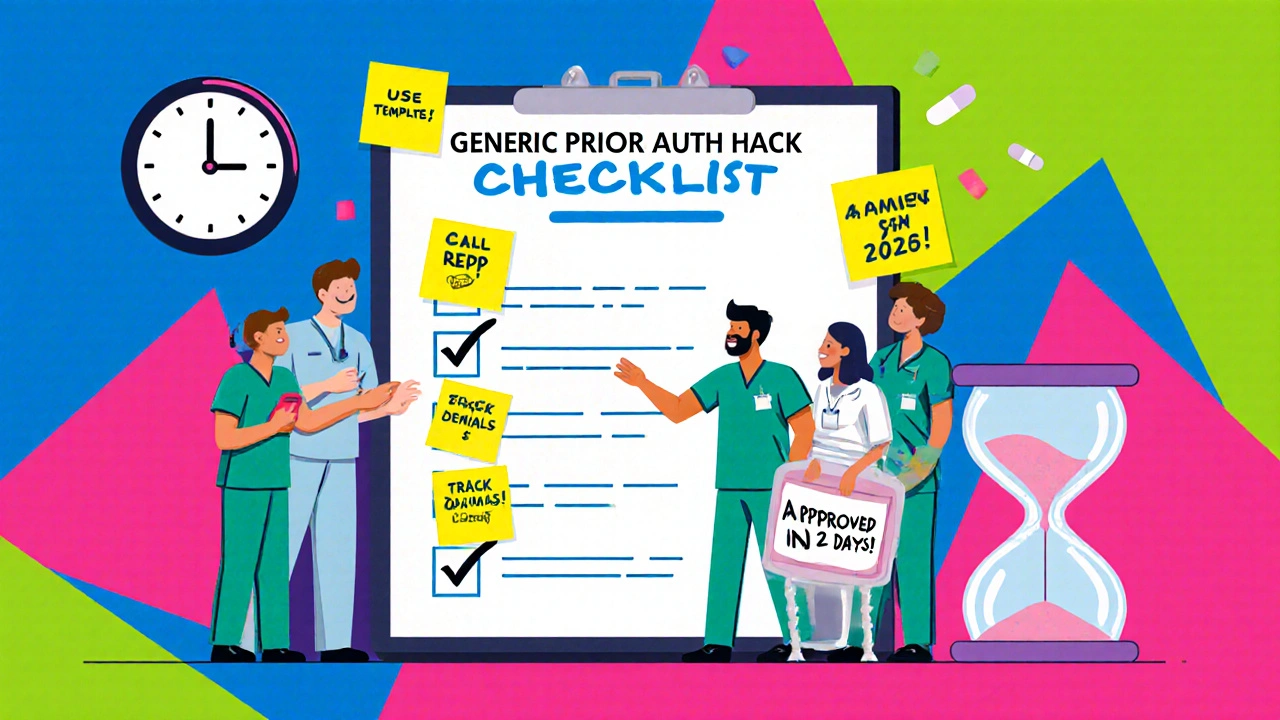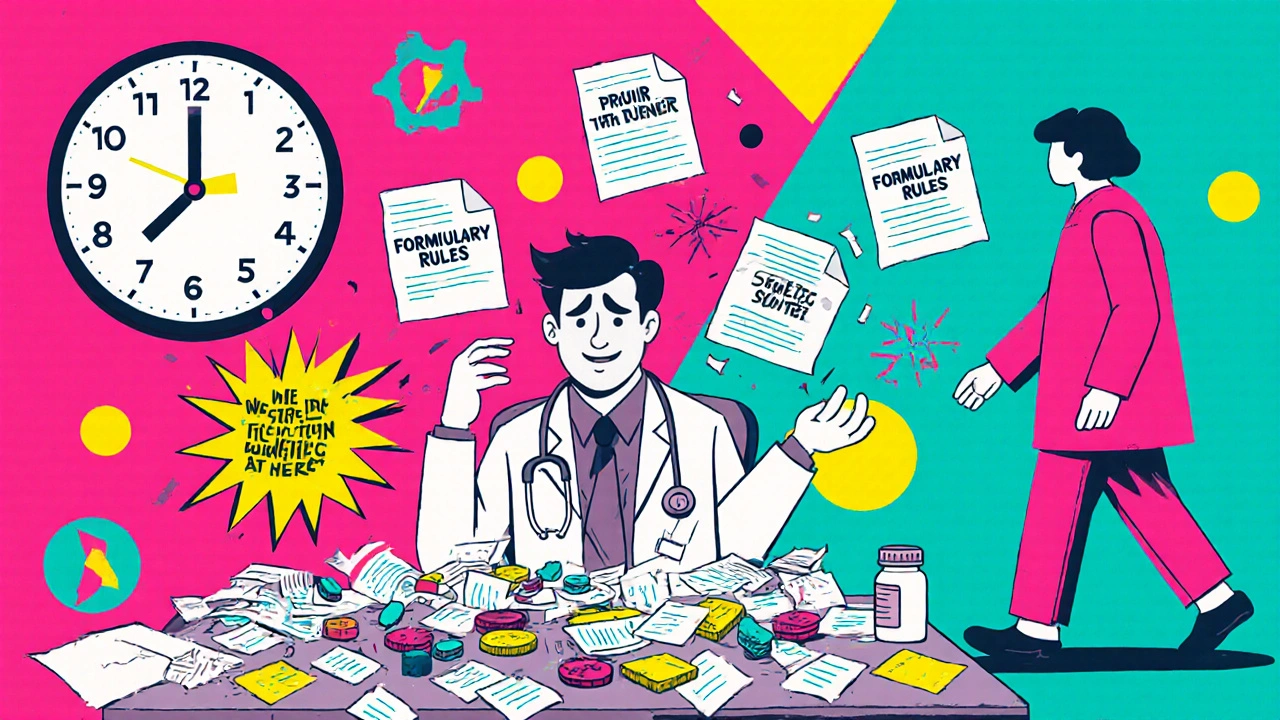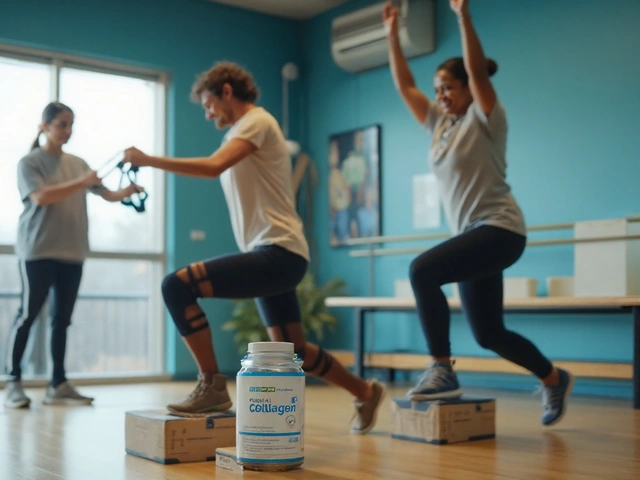Getting a generic medication approved isn’t just about filling out a form. For providers, it’s a daily grind of paperwork, payer rules, and patient delays - all while trying to keep care on track. Even though generics are cheaper and just as effective as brand-name drugs, insurance companies still require prior authorization in many cases. And if you’re a provider, you know how frustrating that can be.
Why Do Insurers Require Prior Authorization for Generics?
It sounds backwards: why block a cheaper drug? The answer lies in how payers manage costs. Prior authorization for generics isn’t about questioning safety - it’s about controlling which version gets used. Many plans have a preferred generic on their formulary. If you prescribe a different generic - even if it’s the same active ingredient - the insurer may deny coverage unless you explain why. For example, a patient with acid reflux might need omeprazole. But the plan only covers the generic made by Company A. If you prescribe the one from Company B, you need to justify it. Maybe the patient had an allergic reaction to Company A’s filler. Maybe they’ve been stable on Company B for years. That’s where documentation comes in. According to the American Medical Association, 92.7% of doctors say prior authorization requests have gone up over the last five years. And 28% of those requests are for generic medications - mostly because of quantity limits, duration caps, or therapeutic interchange rules.When Is Prior Authorization Required for Generics?
Not every generic needs approval. But here’s when it usually does:- Quantity limits: You want to prescribe a 90-day supply, but the plan only covers 30 days without approval.
- Duration limits: Proton pump inhibitors like esomeprazole are capped at 8 weeks unless you prove ongoing need - like a documented case of Barrett’s esophagus.
- Therapeutic interchange: The plan wants you to try their preferred generic first. If the patient had side effects or didn’t respond, you need to document it.
- Off-label use: Even if a generic is FDA-approved for one condition, using it for another (like using metformin for PCOS) may trigger a request.
- Manufacturer restrictions: Some PBMs only cover generics from certain manufacturers. Switching brands mid-treatment? You’ll need to justify it.
The Step-by-Step Process for Getting Approval
There’s no single system. Each payer has its own rules. But here’s how most approvals work:- Check the formulary: Before prescribing, verify which generic versions are covered and if prior authorization is required. Tools like CoverMyMeds or Surescripts can auto-check this.
- Gather documentation: You need clinical proof. That means lab results, diagnostic reports, or clinic notes showing why the requested generic is necessary. For example: an endoscopy report proving Barrett’s esophagus for long-term omeprazole use.
- Submit electronically: 78% of commercial insurers and 63% of Medicare Part D plans now require electronic submission. Fax is fading fast. Paper forms are a relic.
- Wait for response: Medicaid must respond within 24 hours for urgent cases and 14 days for standard ones. Commercial plans take 5-10 business days on average.
- Handle denials: If denied, you’ll get a reason. Common ones? Missing documentation (42%), failure to try preferred alternative (20%), or unclear medical necessity (38%).
How Long Does It Take? Real Numbers
Timing matters. A patient can’t wait two weeks for a blood pressure pill. Here’s what providers actually experience:- 68% of practices report approval in 1-3 days when documentation is complete.
- 7-14 days if the payer asks for more info.
- Generic approvals are typically faster than brand-name - 1-3 days vs. 3-7 days.
- 56% of physicians have had to write bridge prescriptions just to keep patients covered while waiting.
What Works: Strategies That Cut Through the Red Tape
You can’t control the payer’s rules. But you can control how you respond.- Use templates: Create standardized templates for common scenarios - diabetes, acid reflux, hypertension. Capital Rx found providers using templates get approvals 32% faster.
- Train your team: Medical assistants handle 78% of routine prior auth requests under physician supervision. Give them clear checklists and payer-specific guides.
- Build relationships: Call the payer’s provider services line. Get a rep’s name. Know who to follow up with. It makes a difference.
- Go electronic: If your EHR integrates with CoverMyMeds, Surescripts, or another platform, use it. Electronic submissions cut processing time by 35-50%.
- Track everything: Use a simple spreadsheet or software to log submissions, denials, and response times. Patterns emerge - and you can push back with data.
What’s Changing in 2025?
The rules are shifting - fast.- As of July 1, 2024, Medicaid managed care plans must use standardized electronic prior authorization transactions. This should cut processing time by 25%.
- The Improving Seniors’ Timely Access to Care Act (2023) requires Medicare Advantage plans to approve 90% of standard requests within 72 hours - up from 14 days.
- Express Scripts and other PBMs are expanding auto-approve pathways. In 2023, auto-approvals for generics jumped 40%.
- By 2026, McKinsey predicts 75% of generic prior auth decisions will be handled by AI systems - cutting approval time to under 24 hours.

What Providers Are Saying
Real stories from the front lines: > “I got PA approved for omeprazole 40mg daily for 12 weeks for a patient with Barrett’s esophagus. Submitted the endoscopy report via CoverMyMeds. Approved in two days.” - Dr. Michael Chen, Reddit > “Denied for generic sitagliptin because the insurer wanted proof of three failed diabetes meds. But ADA guidelines say metformin intolerance is enough. I had to call three times.” - Dr. Lisa Rodriguez, Sermo These aren’t outliers. They’re routine.Where the System Fails
Prior authorization for generics works best when it’s targeted - like preventing long-term PPI use without monitoring. But it fails when it’s arbitrary.- 89% of providers say documentation rules change between payers - no consistency.
- 76% report delays in getting responses.
- 18.7% of generic prior auth requests are denied - mostly for paperwork errors, not clinical reasons.
What You Can Do Today
You don’t need to wait for policy changes. Start here:- Review your top 5 prescribed generics. Check each one’s prior auth status in your EHR.
- Create one template for a common scenario - say, lisinopril or metformin.
- Assign one staff member to handle prior auth requests full-time for a week. Track time spent and approval rates.
- Call your top 3 payers. Ask: “What’s the most common reason you deny generic prior auth?”
Do all generic medications require prior authorization?
No. Only generics that fall under specific payer restrictions - like quantity limits, duration caps, or preferred drug lists - need prior authorization. Many common generics, like generic ibuprofen or atorvastatin, are covered without approval. But if you’re prescribing a less common generic or a higher dose, check the formulary first.
How long does prior authorization for generics usually take?
With complete documentation and electronic submission, most generic prior authorizations are approved in 1-3 business days. If the payer needs more info, it can stretch to 7-14 days. Medicaid must respond within 24 hours for urgent cases and 14 days for standard ones. Medicare Advantage plans must now approve 90% of standard requests within 72 hours as of January 2024.
Why is prior authorization harder for some generic brands than others?
Some pharmacy benefit managers (PBMs) only cover generics from specific manufacturers. If your patient has been stable on one brand but you prescribe another - even if it’s chemically identical - the payer may require justification. This is often due to rebate agreements, not clinical differences.
Can patients get their generic medication while waiting for approval?
Sometimes, but not always. Many patients can’t afford to pay out-of-pocket, especially for chronic medications. Some providers issue short-term bridge prescriptions or samples if available. Others work with pharmacies to delay filling until approval is granted. The National Community Pharmacists Association found 83% of pharmacists have seen patients walk away because they couldn’t pay upfront.
What’s the easiest way to avoid prior authorization denials for generics?
Document clearly and submit electronically. Always include the reason why the requested generic is necessary - not just the diagnosis. For example: “Patient developed rash with preferred generic lisinopril; switched to alternative generic with no adverse effects.” Use standardized templates. And always check the payer’s formulary before prescribing.






Damon Stangherlin
November 25, 2025 AT 21:40Man, I wish my EHR could auto-fill the PA forms like it does for prescriptions. I spent 45 minutes yesterday justifying why a patient needed omeprazole from Company B instead of Company A. Same active ingredient. Same dose. But nope-paperwork mountain.
At least I’ve got a template now for acid reflux cases. Saved me 20 minutes today. Small wins, right?
Jesús Vásquez pino
November 26, 2025 AT 22:36Let’s be real-prior auth for generics is just insurance companies flexing their power. They don’t care about clinical outcomes. They care about rebates. If Company A pays them 30 cents per pill and Company B pays nothing? Guess which one they want you to prescribe?
Stop pretending this is about patient safety. It’s about profit. And providers? We’re the ones getting crushed under the weight of it.
Gina Banh
November 27, 2025 AT 17:52My favorite part? When the PA denial says ‘insufficient documentation’-but they never tell you what’s missing until you call. Then it’s ‘oh, we need the endoscopy report dated within 6 months’-but the patient had it done 7 months ago because their GI was booked.
It’s not a system. It’s a game of gotcha. And we’re the ones losing.
Also-why does every payer have different rules? It’s like playing 17 different versions of Monopoly with different house rules. No wonder we burn out.
Deirdre Wilson
November 28, 2025 AT 08:29It’s wild how something so simple-like giving someone a pill-turns into a bureaucratic opera. I used to think paperwork was just annoying. Now I see it as a silent tax on care.
Patients don’t care which generic it is. They just want to feel better. And sometimes, by the time we get approval, they’ve already given up.
I keep a little list now. Names of patients who walked away because they couldn’t pay upfront. It’s not just data. It’s ghosts.
Cynthia Boen
November 29, 2025 AT 00:02Ugh. This whole thing is a scam. Why don’t we just abolish prior auth for generics? It’s 2025. We have AI. We have databases. We have *technology*. But no-someone still needs to fax a form and wait two weeks for a ‘yes’.
Meanwhile, my assistant spends 30 hours a week on this junk. That’s a whole FTE we could use for actual patient care.
Amanda Meyer
November 29, 2025 AT 07:26While I agree with the frustrations expressed here, I’d caution against framing this as purely adversarial. Payers are responding to cost pressures too-many of which stem from broader systemic issues in pharmaceutical pricing.
That said, the inconsistency across payers, the lack of standardization, and the administrative burden on providers are undeniable. Perhaps the solution lies not in elimination, but in harmonization-federal standards for generic prior auth, with clear, transparent criteria.
It’s not perfect, but it’s a starting point.
stephen riyo
November 30, 2025 AT 03:07...i just submitted a pa for metformin...and it got auto-approved...because the patient had it last year...but i had to check the formulary...and then log into 3 portals...and then...wait...did i attach the right note...?...i think i did...?...oh god...i forgot to check if the dose was capped...
why does this feel like playing whack-a-mole with my own sanity...
also...i used emoji once...and now i feel weird about it...
😅
Jaspreet Kaur
November 30, 2025 AT 13:57Here in India we don't have this madness...but I've seen friends in the US struggle...and it breaks my heart...
Medicine is supposed to heal...not become a maze of forms and delays...
Why do we let bureaucracy win when lives are on the line?
Someone needs to build a tool that auto-generates PA docs from EHR data...and connects directly to payer APIs...
It's not hard...it's just not prioritized...
Let's fix this...together
Ryan C
December 1, 2025 AT 07:19